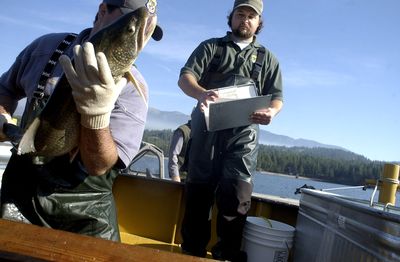Mackinaw harvest gives kokanee shot at comeback

At the Bonner County Food Bank, director Alice Wallace sets no limits on mackinaw.
During spring and late summer, needy families help themselves to packages of fish from a freezer in the food bank’s lobby. Last year, Wallace and her staff gave away 4,700 pounds of the orange-fleshed, mild-tasting fish also known as lake trout.
“It’s got a great flavor,” said Wallace, who uses the trout to add variety to the food bank’s typical meat offerings of hamburger and ground turkey. “We even have one client who smokes it.”
The free trout comes courtesy of the Idaho Department of Fish and Game, which is using mackinaw harvests to restore balance to the waters of Lake Pend Oreille.
Introduced to Idaho’s largest lake in 1925, mackinaw have exhausted their welcome. They gobble up endangered bull trout and kokanee, a landlocked sockeye salmon that once formed the basis of a multimillion-dollar fishery in Lake Pend Oreille. In 2000, the lake closed to kokanee fishing amid steep population declines.
Mackinaw are prodigious feeders, swallowing eight to 10 pounds of smaller fish to put on a single pound of flesh. In other words, “20 pounds of mackinaw may have eaten 200 pounds of kokanee,” said Jim Fredericks, Fish and Game’s regional fisheries manager.
After decades of efforts to curb mackinaw populations and boost kokanee survival, Fish and Game officials finally have some encouraging news.
Last year, the department paid commercial fishermen to pull 20,000 pounds of mackinaw from the lake. Local food banks were “up to their gills” in donated fish, said Chip Corsi, the department’s regional director. And with so many of their predators converted to frozen fillets, kokanee survival rates took a turn for the better.
Last year, survival rates hit 30 percent for 1- to 2-year-old kokanee – the age the fish are typically eaten by mackinaw. Kokanee reach maturity and spawn at 3 to 4 years of age.
Andy Dux, a fish research biologist, cautioned that a single year’s worth of data doesn’t create a trend. But after years of survival rates in the single digits, the results are encouraging, he said. To ensure kokanee’s viability in the lake, survival rates of 60 percent to 70 percent would be better, he said.
Dux’s research led to last year’s bountiful mackinaw harvest. By tagging the trout, he tracked their movements in the lake and found the mackinaw’s two primary spawning grounds. That allowed Harbor Fisheries, a Wisconsin firm that specializes in commercial mackinaw harvest, to catch about 65 percent of Lake Pend Oreille’s reproducing mackinaw.
Fish and Game has worked with Harbor Fisheries for three years. The Bonneville Power Administration and Avista Corp. pay the company’s $434,000 contract as compensation for the destruction of fish habitat from hydropower operations. Avista also pays a $15 per fish bounty to anglers who catch mackinaw.
By repeatedly targeting mackinaw, Fish and Game hopes to quell their populations. That would give kokanee a chance to rebound. Last year, Lake Pend Oreille’s population of spawning-age kokanee was estimated at 60,000. Once, the runs were so abundant that the lake’s annual kokanee harvest topped 1 million fish.
Mackinaw aren’t the only culprits, noted Corsi, Fish and Game’s regional director. Fluctuating lake levels caused by dam operations also played a role in the kokanee’s decline, though agreements with dam operators have helped modify those detrimental effects.
Kokanee aren’t native to Lake Pend Oreille. They arrived in 1934, when massive flooding washed fish out of Montana’s Flathead Lake, sending them down the Clark Fork River and into Lake Pend Oreille.
But unlike mackinaw, kokanee are a beneficial presence in the lake, Corsi said. As native cutthroat trout numbers dwindled, kokanee become a critical part of the food chain, feeding animals from eagles and grizzly bears to otter and bull trout. The fish spawn in tributary streams and shallow areas along the lakeshore, allowing scavengers to pick over their carcasses. Mackinaw spawn and die in deeper waters, so less of their flesh gets recycled, Corsi said.
High in healthy fats, kokanee taste similar to oceangoing sockeye, which also make them a favorite of fishermen. They’re easy to catch, too.
“Any mom and pop can go out on a dinghy and catch kokanee,” Corsi said. “It’s pretty hard to find anyone who doesn’t like kokanee and who doesn’t want them in the lake.”
When Jim Carothers, of Sagle, Idaho, was a kid, he helped his grandparents and aunt and uncle run a commercial kokanee operation on Lake Pend Oreille. His relatives sold their catch to a local smokehouse. Fishing helped augment income from the family’s farm into the 1970s.
Those days are long past, Carothers noted. But restored kokanee runs could still help the local economy, he said.
Fish and Game wants to recover kokanee to reopen a sport fishery. Carothers would like to see the kokanee restored to feed the populations of other game fish, such as the record-size Kamloops rainbow trout Lake Pend Oreille is known for. The Kamloops bring big money into the local economy through the presence of charter boats and out-of-town anglers willing to spend hundreds of dollars to catch a trophy fish, Carothers said.
To further that goal, “I’m of the belief that we shouldn’t have a kokanee fishery and you can walk from shore to shore on them,” he said.